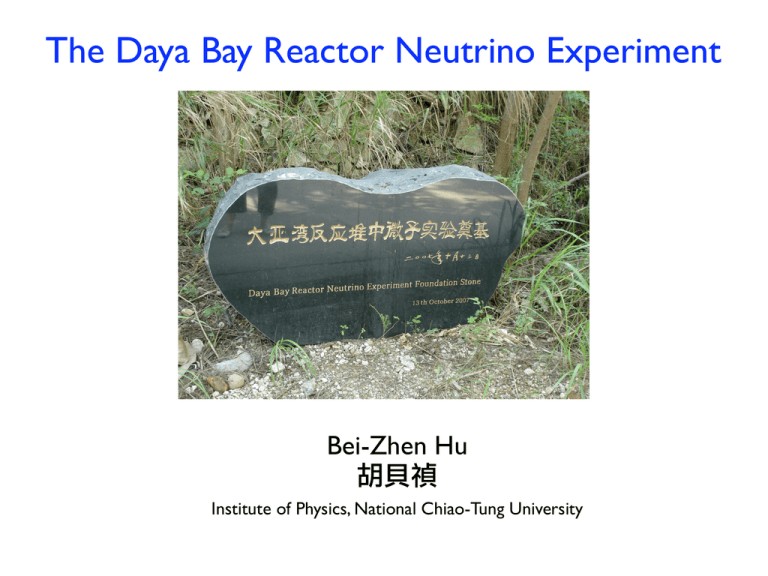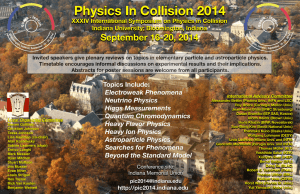The Daya Bay Reactor Neutrino Experiment Bei-Zhen Hu 胡貝禎
advertisement

The Daya Bay Reactor Neutrino Experiment Bei-Zhen Hu 胡貝禎 Institute of Physics, National Chiao-Tung University Daya Bay Collaborators Europe (3) JINR, Dubna, Russia Kurchatov Inst., Russia Charles Univ., Czech Republic North America (16) BNL, Caltech, Univ. of Cincinnati, George Mason Univ., LBNL, Princeton, RPI, Siena College, UC-Berkeley, Asia (19) UCLA, Univ. of Houston, Univ. of Wisconsin, Virginia Beijing Normal Univ., Chengdu Univ. of Tech., CGNPG, CIAE, Tech., Univ. of Illinois at Urbana-Champaign Dongguan Univ. of Tech., IHEP, Nankai Univ., Nanjing Univ., Shandong Univ., Shanghai Jiaotong Univ., Shenzhen Univ., Tsinghua Univ., USTC, Zhongshan Univ., Chinese Univ. of Hong Kong, Univ. of Hong Kong, National Chiao Tung Univ., National Taiwan Univ., National United Univ. B. Z. Hu April 1, 2011 Outline ● A brief introduction to neutrino oscillation ● Motivation ● Neutrino Detection ● Why Daya Bay? ● Experimental Layout - Optimized Baseline - Method of Measurement ● Daya Bay Detectors - Anti-neutrino Detector - Gd-doped Liquid Scintillator - PMT ● Electronics, Trigger, DAQ & Offline ● Design Considerations ● Measuring sin22θ13 to 0.01 ● Status ● Schedule B. Z. Hu April 1, 2011 A brief introduction to neutrino oscillation Bruno Pontecorvo First suggestion that neutrinos can “mix” (change from one type to another). This require massive neutrinos. να : weak eigenstates; α = e, µ, τ. νi : mass eigenstates; i = 1, 2, 3. U : 3x3 PMNS unitary matrix. B. Z. Hu April 1, 2011 A brief introduction to neutrino oscillation The role of θ13 : 1. Complete basic model of neutrino oscillations. PMNS(Pontecorvo–Maki–Nakagawa–Sakat) Matrix U = θ12 ~ 32° B. Z. Hu θ23 ~ 45° April 1, 2011 Motivation The role of θ13 : 1. Complete basic model of neutrino oscillations. PMNS(Pontecorvo–Maki–Nakagawa–Sakat) Matrix U = 2. If θ13 between 0.01~0.03 => determine CP phase δCP. 3. The mass hierarchy depends on the size of θ13. ※ Our goal: to determine the unknown neutrino mixing angle θ13 with a sensitivity of 0.01 or better in sin22θ13. B. Z. Hu April 1, 2011 Neutrino Detection Inverse beta decay reaction ● Prompt-delayed coincidence B. Z. Hu April 1, 2011 Neutrino Detection Inverse beta decay reaction ● Prompt-delayed coincidence Prompt signal Delayed signal B. Z. Hu April 1, 2011 Neutrino Detection Inverse beta decay reaction ● Prompt-delayed coincidence Prompt signal ~28 μs Delayed signal 49,000 b 0.3 b ● Why Gd? - neutron capture delayed signal is far from natural radioactivity. - Large capture cross section - Short capture time B. Z. Hu April 1, 2011 A powerful neutrino source ● By 2011, the 2nd most powerful complexes in the world (17.4 GWth). ● Adjacent to mountains, easy to construct labs with sufficient overburden to suppress cosmogenic backgrounds B. Z. Hu April 1, 2011 Optimized Baseline ● Probability: P12 P13 Psur B. Z. Hu April 1, 2011 Experimental Layout ● Three experimental halls Multiple detectors at each site Side by side calibration ● Movable Detector All detectors are filled with the same batch of Gd-LS Far Site Far: 80 ton 1600m to LA, 1900m to DYB Overburden: 355m Muon rate: 0.04Hz/m2 LA Near Entrance B. Z. Hu DYB Near LA: 40 ton Baseline: 500m Overburden: 112m Muon rate: 0.73Hz/m2 DYB: 40 ton Baseline: 360m Overburden: 98m Muon rate: 1.2Hz/m2 April 1, 2011 Method of Measurement ● The detection concept: sample the reactor anti-neutrino flux in the near and far locations, and look for evidence of disappearance. B. Z. Hu April 1, 2011 Daya Bay Detectors Far site experimental hall Muon Veto System ● 4-layer RPCs ● Water Cherenkov Detector - 2.5m thick water to shield backgrounds from neutrons and γ’s from rock - 2-zone (Inner water and Outer water) separated by reflective Tyvek. 10 m Anti-neutrino detector 16 m ※ The water detector + the RPC roof achieve a very high muon veto efficiency: εcombined > (99.5±0.25)% B. Z. Hu April 1, 2011 Anti-neutrino Detectors ● 3 Zone detector: Zone Liquid Purpose Inner AV (3m) Gd-doped LS Anti-neutrino target Outer AV (4m) LS Gamma catcher SSV (5m) Mineral Oil Radiation shielding PMT ● 192 8” PMTs in mineral oil buffer. ● 20 ton Gd doped LS ● Top/bottom reflectors. Reflectors ● Automatic calibration units (ACU). AV: Acrylic Vessel SSV : Stainless steel vessel LS : Liquid Scintillator B. Z. Hu Calibration system Gd-LS 3m 4m 5m April 1, 2011 Gd-doped Liquid Scintillator ● Requirements on Gd-LS - Long stability (experiment running time: 3-5 years) - Good transparency, attenuation length > 10 m - High light yield ( 50% Anthracene ) - Low radioactivity, compatible with acrylic ● Daya Bay Gd-LS recipe - Solvent: LAB (Linear Alkyl Benzene) - Fluor: PPO (3g/L), bis-MSB (15 mg/L) - 0.1% Gd B. Z. Hu April 1, 2011 Gd-doped Liquid Scintillator B. Z. Hu April 1, 2011 PMT Photomultiplier Tube (PMT) ● 192 8” PMTs in each AD; 960 8” PMTs in water pool (total) ● Hamamatsu R5912 low radioactive glass PMT High Voltage System ● CAEN SY1527LC Mainframe ● 1934A HV modules B. Z. Hu April 1, 2011 Electronics, Trigger, DAQ & Offline B. Z. Hu April 1, 2011 Design Considerations - Identical near and far detectors to cancel reactor-related errors - Multiple modules for reducing detector-related errors and cross checks - Three-zone detector modules to reduce detector-related errors - Overburden and shielding to reduce bakgrounds - Multiple muon detectors for reducing background and cross checks - Movable detectors for swapping B. Z. Hu April 1, 2011 Measuring sin22θ13 to 0.01 High statistics ● 17.4 GW NPP at Daya Bay, 80 ton target statistical error 0.2% in 3 years B. Z. Hu April 1, 2011 Status - civil Far site LA near site LS Hall Tunnel Tunnel: 3.2 km SAB Surface assembly building DYB near site B. Z. Hu April 1, 2011 Status - Detector Assembly B. Z. Hu April 1, 2011 Schedule ● October 2007, Ground Breaking ● March 2009, Surface assembly building ready ● October 2010, first AD pair complete, Dry-Run tests finished ● October 2010, Daya Bay Near Hall Occupancy ◎ We are going to fill in the Gd-LS ◎ Daya Bay Hall ready by Fall 2011 ◎ Ling Ao and Far Halls ready by Fall 2012 B. Z. Hu April 1, 2011 Thank you!





